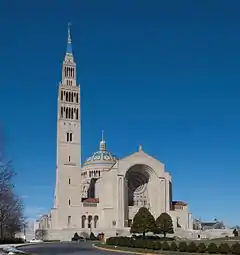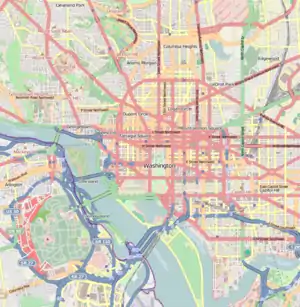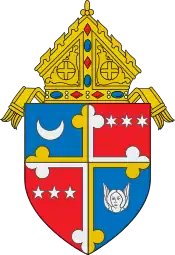Basilica of the National Shrine of the Immaculate Conception
The Basilica of the National Shrine of the Immaculate Conception is a large Catholic minor basilica and national shrine located in Washington, D.C., United States, on 400 Michigan Ave NE, Washington, DC 20017, near the Catholic University of America.
| Basilica of the National Shrine of the Immaculate Conception | |
|---|---|
| National and Patronal Church of the United States of America "America's Catholic Church" | |
 Main façade of the Basilica of the National Shrine of the Immaculate Conception | |
 Location of the Basilica of the National Shrine of the Immaculate Conception in Washington, D.C. | |
| 38°56′0″N 77°0′02″W | |
| Location | Washington, D.C. |
| Country | United States |
| Denomination | Roman Catholic |
| Tradition | Roman Rite |
| Website | Basilica of the National Shrine of the Immaculate Conception |
| History | |
| Status | Minor basilica, National shrine |
| Dedication | Immaculate Conception |
| Dedicated | November 20, 1959 |
| Consecrated | September 23, 1920 |
| Architecture | |
| Architect(s) | Maginnis & Walsh |
| Architectural type | Basilica |
| Style | Byzantine Revival and Romanesque Revival |
| Groundbreaking | April 20, 1924 |
| Completed | December 8, 2017 |
| Specifications | |
| Capacity | 10,000 (6,000 in the Great Upper Church; 4,000 in the Crypt Church)[1] |
| Length | 459 feet (140 m)[1] |
| Width | 240 feet (73 m)[1] |
| Nave width | 157 feet (48 m)[1] |
| Height | 329 feet (100 m)[1] |
| Dome height (outer) | 237 feet (72 m)[1] |
| Dome height (inner) | 159 feet (48 m)[1] |
| Dome diameter (outer) | 108 feet (33 m)[1] |
| Dome diameter (inner) | 89 feet (27 m)[1] |
| Administration | |
| Archdiocese | Archdiocese of Washington |
| Clergy | |
| Archbishop | Wilton Daniel Gregory |
| Rector | Reverend Monsignor Walter R. Rossi |
| Priest(s) | Reverend Monsignor Walter R. Rossi Reverend Monsignor Vito A. Buonanno Reverend Michael D. Weston Reverend Raymond A. Lebrun, OMI |
| Laity | |
| Director of music | Dr. Peter J. Latona, D.M.A. Mr. Benjamin LaPrarie (Associate Director of music) |
| Organist(s) | Dr. Peter J. Latona, D.M.A. Mr. Andrew Vu (Associate organist) Dr. Robert Grogan, D.M.A., (Carillonneur and Organist emeritus) |
The shrine is the largest Christian church in the United States and in North America,[2] and one of the largest in the world.[3]The basilica is also the tallest habitable building in Washington, D.C.[4][5][6] Its construction of Byzantine Revival and Romanesque Revival architecture began on September 23, 1920, with renowned contractor John McShain and was completed on December 8, 2017, with the dedication and solemn blessing of the Trinity Dome mosaic.
The basilica is the national and patronal Catholic Church of the United States,[4] honoring the Immaculate Conception as Patroness, accorded by Pope Pius IX in 1847. Pope Pius XI donated a mosaic rendition of the image in 1923. The shrine has merited several papal visits, namely the following:
- Pope John Paul II raised the National Shrine to the status of Minor Basilica on October 12, 1990.
- Pope Benedict XVI bestowed a Golden Rose on April 16, 2008.
- Pope Francis canonized Saint Junípero Serra, O.F.M., on September 23, 2015.
The basilica does not have its own parish community, but serves the adjacent Catholic University of America, the United States Conference of Catholic Bishops, and hosts numerous Masses for various organizations of the Church from across the United States. The basilica is not the cathedral church of the Archdiocese of Washington, as that title and honor belongs to the Cathedral of St. Matthew the Apostle.
The shrine's rector is the Reverend Monsignor Walter R. Rossi, who was found innocent after a 10-month long investigation was launched by his home Diocese of Scranton for alleged misconduct.[7]
Architecture

The basilica houses 81 Marian chapels (including the Our Mother of Africa Chapel), as well as other sacred images, flanking the sides of the Great Upper Church and the Crypt Church.[8] They were designed to reflect the origins of Catholic Americans and the religious orders whose generosity erected them.
Its Greek-styled interior is crowned with numerous domes decorated in mosaics, similar to the Basilica of St. Mark in Venice, Italy, but much larger. The mosaics feature American renditions of traditional Catholic images. Artist Jan Henryk De Rosen, who presided over the shrine's iconography committee was also responsible for much of its decor, including composing the large mosaic over the northern apse.
The exterior of the basilica is 459 ft (140 m) long, 240 ft (73 m) wide, and 237 ft (72 m) tall to the top of the cross on the dome. The exterior area of the basilica is 19,166 square metres (206,300 sq ft).[1][9] The diameter of the main dome (the Trinity Dome) of the basilica is only 7 feet (2 m) smaller than that of the dome of the United States Capitol. The interior area of the basilica is 12,069 square metres (129,910 sq ft).[1]
The shrine was built in the style of medieval churches, relying on masonry walls and columns in place of structural steel and reinforced concrete. It was designed to hold 10,000 worshipers and includes modern amenities such as a basement cafeteria, hidden public address speakers to carry speech at the altar to the rear of the building, air conditioning and 1959's largest radiant heating slab in the world.[10]
There are arches outlined with iridescent Pewabic Pottery tile, large ceramic medallions set in the ceiling, and fourteen Stations of the Cross in the Crypt Church.[11]
History
Patronage of the Immaculate Conception
In 1792 John Carroll, the bishop of Baltimore and the United States's first Catholic bishop, consecrated the newly created United States under the protection of the Blessed Virgin Mary under the title of the Immaculate Conception. In 1847, the 7th Provincial Councils of Baltimore reiterated this episcopal choice to name the title Virgin Mary, conceived without sin as the principal patroness of the land. Pope Pius IX formalized the decision on February 7, 1847, and it was published on July 2, 1847.
Construction (20th Century)

Bishop Thomas Joseph Shahan, the fourth rector of The Catholic University of America in Washington, proposed the construction of a national shrine to commemorate the Immaculate Conception in the country's capital. Bishop Shahan took his appeal to Pope Pius X on August 15, 1913.[12]
Shahan received the pope's enthusiastic support and personal contribution of US$400 ($10,000 adjusted for inflation). Shahan returned to the United States and persuaded the board of trustees of The Catholic University of America to donate land at the southwest corner of the campus for his shrine.
In January 1914, Shahan published the first issue of Salve Regina, a newsletter meant to stir enthusiasm for his project. He wrote that the shrine would be a "monument of love and gratitude, a great hymn in stone as perfect as the art of man can make it and as holy as the intentions of its builders could wish it to be." His newsletter was circulated to dioceses throughout the country and financial donations began to pour into Washington. In 1915, Shahan appointed Father Bernard McKenna of Philadelphia as first director of the national shrine. Shahan oversaw the construction of the shrine until his death on March 9, 1932. His are the only remains interred at the basilica/national shrine.
By 1919, Shahan and McKenna chose architectural drawings by the Boston firm of Maginnis & Walsh for construction of the national shrine. Initially, they considered a traditional Neo-Gothic architectural style, but Shahan opted instead for a Byzantine Revival-Romanesque Revival design.[13] Cardinal James Gibbons, archbishop of Baltimore, blessed the foundation stone on September 23, 1920. More than 10,000 people attended the Mass, including ambassadors, government officials, and military officers. In 1929, the Great Depression halted the construction above the Crypt Church level. The beginning of American involvement in World War II stalled plans even further.
After the war, in 1953, American bishops under the leadership of John Noll, archbishop ad personam of Fort Wayne, and Patrick O'Boyle, archbishop of Washington, pledged to raise the funds necessary to complete the Great Upper Church of the national shrine. On November 20, 1959, thousands of Catholics gathered with the bishops for the dedication of the Great Upper Church.
Since 1968, the Papal Tiara of Pope Paul VI has been on display inside the Crypt Church.[14]
On October 12, 1990, Pope John Paul II raised the national shrine to the status of minor basilica. The papal bull was signed and notarized by Cardinal Agostino Casaroli. It is the 36th designated basilica within the United States.
Completion (21st Century)
.jpg.webp)
In August 2006, work was completed on a mosaic covering the Redemption Dome in the Great Upper Church. Following its completion in the summer of 2007, the Incarnation Dome was blessed on November 17, 2007.[15] A small chapel on the Crypt Church level honoring Our Lady of La Vang (Vietnam) was completed in 2006.[16]
In 2008, during his apostolic visit to the United States, Pope Benedict XVI bestowed the Golden Rose upon the Basilica of the National Shrine of the Immaculate Conception.[17]
In June 2011, a new chapel dedicated to Our Lady of Lebanon was erected within the basilica, commemorating the fidelity of the Maronite Church and its faithful. A mosaic of Saint Maroun and the Crucifixion was copied from the 6th-century Rabboula Maronite manuscript, and was donated by Cardinal Donald Wuerl. The chapel was formally consecrated by Maronite Bishop Gregory J. Mansour on September 23, 2011.[18]
On January 26, 2013, the basilica held a televised thanksgiving Mass and enshrined two first class relics of Americans Kateri Tekakwitha and Marianne Cope, who were both canonized October 20, 2012.[19]
Pope Francis visited the shrine on September 23, 2015, and celebrated a Mass for the canonization of Junípero Serra, O.F.M., on the mall of the Catholic University of America. The altar, ambo, and chair used for this Mass match the existing marble in the basilica. After the Mass, the papal altar was placed in front of the High Altar, and is now used as the altar in the Great Upper Church.[20]
On February 20, 2016, the Basilica was the site of the funeral Mass of US Supreme Court Justice Antonin Scalia at which his son Fr. Paul Scalia was the celebrant.[21]
The final architectural element was completed with the installation of the 24 tons of Venetian glass in the central Trinity Dome, one of the largest mosaics of its kind in the world. On December 8, 2017, the Feast of the Immaculate Conception, the dome was dedicated and solemnly blessed by Cardinal Donald Wuerl.[22]
Priests of the Basilica
Staff of the Basilica
- Dr. Peter J. Latona, D.M.A.—Director of Music
- Mrs. Dee Steel—Director of Visitor Services
- Ms. Jacquelyn Hayes—Director of Communications
- Ms. Amy Maloney—National Shrine Shops Manager
- Dame Valencia Yvonne Camp LGCHS—Director of Special Events and Operations Manager
- Dr. Geraldine M. Rohling, Ph.D., M.A.Ed.—Archivist and Curator
Gallery
Exterior
 The basilica viewed from atop the Washington Monument
The basilica viewed from atop the Washington Monument The liturgical east end of the basilica
The liturgical east end of the basilica The basilica viewed from the side
The basilica viewed from the side Detail of the dome
Detail of the dome.jpg.webp) Bell tower
Bell tower The basilica under lighting
The basilica under lighting
Interior
 View of the basilica's Great Upper Church nave
View of the basilica's Great Upper Church nave View of the basilica's Crypt Church nave
View of the basilica's Crypt Church nave Stained glass window in the basilica
Stained glass window in the basilica Bishop's vesting altar in the Great Upper Church sacristy
Bishop's vesting altar in the Great Upper Church sacristy The papal tiara of Pope Paul VI
The papal tiara of Pope Paul VI Golden Rose bestowed by Pope Benedict XVI
Golden Rose bestowed by Pope Benedict XVI
See also
- Mary, Protector of Faith Sculpture in Mary's Garden
- Top eight Catholic pilgrimage destinations in the United States
- Ukrainian Catholic National Shrine of the Holy Family
- List of basilicas
- List of the Roman Catholic cathedrals of the United States
- List of the Roman Catholic dioceses of the United States
- List of tallest domes
- Franciscan Monastery of the Holy Land in America
References
- "Architectural Details of the Basilica" (PDF). National Shrine. Retrieved July 24, 2019.
- due to Trinity Dome being finished
- "20 Largest Churches in the World". Wander. Retrieved July 28, 2020.
- "Basilica of the National Shrine of the Immaculate Conception". National Shrine. Archived from the original on February 3, 2009. Retrieved July 23, 2011.
- "The National Shrine". SkyscraperPage.com. Archived from the original on October 5, 2008. Retrieved July 23, 2011.
- The Washington Monument is a taller structure, (though it stands at a lower elevation) but is not a habitable building.
- Condon, Ed; JD Flynn (June 12, 2020). "Scranton diocese: 'No credible evidence' against Msgr. Walter Rossi". The Catholic World Report. Catholic News Agency. Retrieved September 6, 2020.
- Clay, Jennifer (April 2005). "National Shrine of the Immaculate Conception". The Washington Post. Archived from the original on April 20, 2012.
- "Architectural Style". National Shrine of the Immaculate Conception. Archived from the original on February 8, 2009. Retrieved March 24, 2009.
- "National Catholic Shrine Will be Dedicated Nov. 20". Reading Eagle. United Press International. November 8, 1959. Retrieved July 23, 2011.
- Bruner, Lousie (July 5, 1977). "Historian, Print Specialist Begin Museum Duties". The Blade. Toledo. Retrieved July 23, 2011.
- Morgan, David G.; Promey, Sally M. (2001). The Visual Culture of American Religions. University of California Press. p. 76. ISBN 978-0-520-22522-0.
- Morgan (2001), p. 79.
- Dugan, George (December 1, 1964). "Spellman's Surprise: Pope's Tiara Is Here". The New York Times. Retrieved February 24, 2017.
- McLaughlin, Moira (June 23, 2007). "A Work of Art in Many Pieces". The Washington Post. Retrieved July 23, 2011.
- Black, Meredith (June 27, 2008). "Vietnamese Catholics Gather at National Shrine to celebrate their faith". Catholic Standard. Washington. Retrieved July 23, 2011.
- "Pope, US bishops exchange gifts" (Press release). CatholicCulture.org. April 17, 2008. Retrieved July 23, 2011.
- Szczepanowski, Richard (September 26, 2011). "New chapel dedicated to Our Lady of Lebanon at national shrine". The Catholic Review. Baltimore. Retrieved September 6, 2020.
- Sparke, Andy (July 23, 2013). "Native Americans celebrate faith, spirituality at Tekakwitha gathering". The Catholic Sun. Phoenix. Catholic News Service.
- Mena, Adelaide (June 8, 2015). "An altar for Pope Francis: CUA students' design to enliven DC Mass". Catholic News Agency. Retrieved September 1, 2018.
- Wolf, Richard; Korte, Gregory (February 20, 2016). "At funeral Mass, Justice Scalia eulogized as a man of faith as well as law". USA Today.
- Samber, Sharon (December 9, 2017). "After a century, the largest Catholic church in North America is finally complete". USA Today. Retrieved December 10, 2017.
Further reading
- Tucker, Gregory W. (February 1, 2000). America's Church: The Basilica of the National Shrine of the Immaculate Conception. Our Sunday Visitor. ISBN 978-0-87973-700-9.
External links
| Wikimedia Commons has media related to Basilica of the National Shrine of the Immaculate Conception. |
- Official website
- Historic American Buildings Survey (HABS) No. DC-859, "Basilica of the National Shrine of Immaculate Conception, 400 Michigan Avenue N.W., Washington, District of Columbia, DC"
- Basilica of the National Shrine of the Immaculate Conception: Photo Gallery by The Catholic Photographer
- Sculpture on the exterior of the Basilica (more than 100 pieces)
- www.stainedglassphotography.com – images of the artwork in the Basilica
| Preceded by Old Post Office Building (Washington, D.C.) |
Tallest Building in Washington, D.C. 1959–present 100m |
Succeeded by None |



